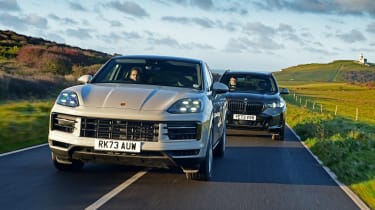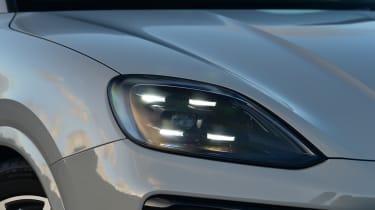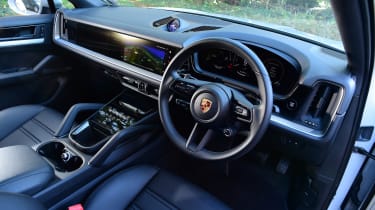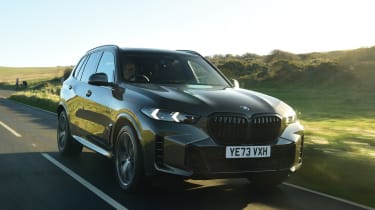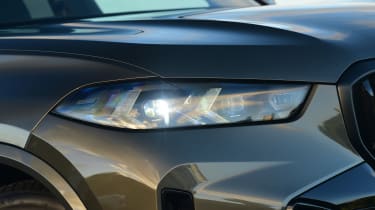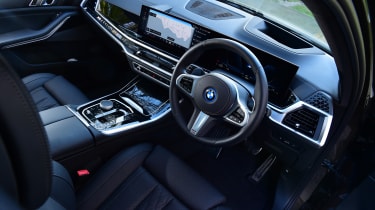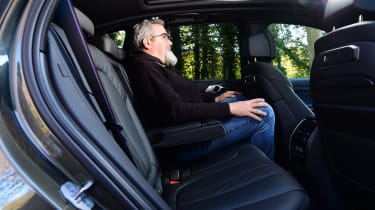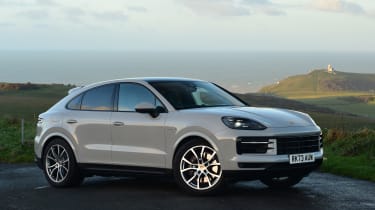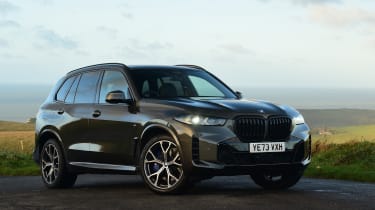Porsche Cayenne vs BMW X5 2024 twin test: sporty plug-in hybrids battle for supremacy
Porsche and BMW have updated their sporty plug-in hybrid SUVs – which one is best?
Luxury models are often at the cutting edge of new-car technology, and the large SUV segment is one area that has seen plenty of developments in terms of plug-in hybrid systems. Here we’re testing two of the very best of the breed. The third-generation Porsche Cayenne has received a facelift that includes updates to the E-Hybrid model, with more power for the electric motor and a bigger drive battery. However, the BMW X5 has also been revised, and the xDrive45e has been replaced by the xDrive50e. The different name signifies more power, while it also gains a larger battery.
Of course, these two manufacturers are known for their sporting models, and the Cayenne and X5 are two of the most entertaining large SUVs available. Do they still deliver driving enjoyment when a hybrid powertrain is added to the mix?
| Porsche Cayenne E-Hybrid | BMW X5 xDrive50e M Sport | |
| Price: | £79,800 | £80,835 |
| Powertrain: | 3.0-litre V6 twin-turbo petrol plug-in hybrid, 463bhp | 3.0 6cyl twin-turbo petrol plug-in hybrid, 483bhp |
| 0-62mph: | 4.9 seconds | 4.8 seconds |
| Efficiency: | 188.3mpg/41.4mpl | 313.9mpg/69mpl |
| Official CO2 | 33g/km | 21g/km |
| Annual VED: | £560 | £560 |
Porsche Cayenne
The updated Cayenne features a tweaked look and revised interior tech, plus this E-Hybrid model has more power and a longer range than before. While the car in our pictures is a Cayenne Coupé, we’re testing the standard SUV version against the X5 here. A starting price of £79,800 is less than the BMW’s, but that can be easily increased by adding options.
Tech highlights
Subtle styling revisions mean that spotting an updated Cayenne will be tricky for anyone other than a Porsche enthusiast, but the main differences on the outside are a redesigned front bumper and boxier headlight units. These are now fitted with Matrix LEDs as standard across the Cayenne range, while Taycan-style HD Matrix lights that use 32,000 pixels per lamp are available as a £1,755 option.
Inside, the Cayenne features a new dashboard layout that mirrors that of the Taycan EV, with a 12.6-inch dashboard display and additional gloss-black trim, while the drive selector has been moved from the centre console to a position just next to the dials to free up cabin space.
Under the skin, the Cayenne uses the VW Group’s MLB Evo platform. It’s shared with a range of other large SUVs, but Porsche tailors the suspension and steering to deliver the kind of involving handling that its customers expects.
Hybrid: The E-Hybrid has been enhanced with power boosts for the engine and electric motor, with the turbocharged V6 up by 8bhp to 464bhp, and an increase of 30bhp for the motor, to 174bhp. There’s a bigger battery, too, up from 17.9kWh to 25.9kWh, which offers a range of up to 29 miles in EV mode. However, all of these figures are a little behind those quoted for the BMW.
On road
The Cayenne’s breadth of ability more than makes up for the extra weight that the E-Hybrid carries when compared with the standard Cayenne.
Around town: The hybrid system adds just over 300kg to the Cayenne, but the benefits are felt as soon as you pull away. At lower speeds, the Porsche uses electric drive as often as possible, so it remains quiet and refined, while the ride is settled, despite wheels that start from 20 inches.
Our car was fitted with a rear-axle steering system, which can be added when adaptive air suspension and speed-sensitive power steering are also fitted (combining these extras adds £3,307 to the price). This boosts manoeuvrability at low speeds, while good visibility from the driver’s seat and a standard-fit reversing camera, plus front and rear parking sensors, make life easier.
A & B-roads: That rear-wheel steering system also boosts the Cayenne’s agility, and goes some way to negating the additional weight the E-Hybrid has to carry. The steering feels direct and the chassis is agile, while switching between electric drive and V6 power is seamless.
If adaptive air suspension is fitted, then the drive modes offer different levels of stiffness. At the top of the scale is Sport Plus, which is a bit too harsh for the road, but switching to Sport provides a good balance between comfort and control when you’re tackling twisty roads.
Motorway: If there’s enough charge in the battery, then the Cayenne can run on electric drive alone at speeds up to 84mph, although on the motorway it’s road noise that’s heard above anything else – not that it’s intrusive. Comfort mode for the air suspension delivers a pliant and smooth ride.
Ownership
The main updates to the Cayenne focus on the dashboard and centre console, where the simplified touchscreen set-up from the Taycan has been installed. It means there’s a cleaner look ahead of the driver, while a bank of controls are arranged on the gloss-black centre console where the drive selector used to be.
A large curved digital driver’s display sits ahead of the steering wheel, but it still retains a traditional Porsche layout, with a central speedometer flanked by secondary dials, both of which are configurable to show different information. There’s no cowl over the dials, but the curved display doesn’t suffer from reflections or glare.
Build quality is as good as we’ve come to expect from Porsche, but there are some harder materials dotted around the cabin. The door releases, for example, are made of hard plastic, so they’re not as satisfying to use as the metallic items found in the X5. Some of the leather trim feels harder in places, too, especially if the cabin is upgraded with more upmarket upholstery.
One thing that’s beyond doubt is the quality of the Porsche ownership experience. Respondents to the Driver Power survey placed the marque in first place above all other makers in 2023, and they are equally positive about the after-sales service. So while purchase and running costs can be expensive, there’s a sense that you get what you pay for.
Practicality
The Cayenne is a close match to the X5 for passenger and boot space.
Rear space: The car in our pictures is a Coupé, but its rakish roofline doesn’t compromise headroom because the Cayenne’s seats are set low. Space will be even greater in the standard SUV.
Rear legroom is better than in the BMW, but the X5 is slightly wider across the back. Cayenne passengers get air vents (but no temperature control) and USB-C sockets.
Boot: There’s a low load lip for the Cayenne, which can be dropped further if the optional air suspension is fitted. This is easily activated via a button in the side of the cargo area.
The back seats fold completely flat, although there’s less space on offer in two-seat mode than there is in its BMW rival, with 1,563 litres available compared with 1,720 litres for the X5.
What to buy?
Which engine and trim we’d choose…
- Powertrains: Porsche offers three PHEVs in its line-up, the E-Hybrid tested here, plus the S E-Hybrid and Turbo E-Hybrid. The S is £7,300 extra and has the same V6 powertrain bumped up to 512bhp, while the Turbo is based on a V8 petrol and has 729bhp. It costs £50,400 more than the E-Hybrid.
- Options: Each engine is its own trim level, but Porsche offers an extensive range of upgrades to personalise the Cayenne. There are wheel, exterior and trim options, you can add kit to make the cabin more comfortable, and there are chassis upgrades available, too.
- Our choice: An E-Hybrid with adaptive air and rear-wheel steering is a great combo.
BMW X5
A revised plug-in hybrid powertrain was introduced to the X5 line-up at the end of 2023, and with it came more power and a new name, because the xDrive45e was replaced by the xDrive50e. It only comes in M Sport trim, while the £80,835 list price of our test car was bumped up by £19,104 worth of options.
Tech highlights
The xDrive50e gets a new number because its combined output is a healthy 95bhp more than the outgoing xDrive45e had. And with 483bhp on tap, it’s 20bhp ahead of the Cayenne, too.
Most of the extra power comes from the electric motor; while the BMW’s 309bhp turbocharged in-line six is only 9bhp ahead of the Porsche’s V6, the electric motor packs 194bhp, which is 20bhp more than the Cayenne’s unit. There’s also a bigger battery than before, up from 24kWh to 29.5kWh, and BMW claims a range of 60 miles from a full charge.
There are other tweaks beyond the drivetrain, with redesigned bumpers and a new lighting signature bringing the X5 into line with newer models in the range. There are updates inside, too, with the latest infotainment tech and screens. Given that this is a mid-life facelift, the X5’s basic underpinnings remain unchanged, so the company’s CLAR platform features, while this PHEV version has air suspension fitted as standard. It’s a £1,760 option on the Porsche.
Safety: While the Cayenne hasn’t been tested by Euro NCAP, the X5 has, and it earned a five-star rating. Percentage scores were high across the board, too. Both cars feature the latest safety tech, though, including multiple airbags, plus radar and camera systems that monitor the surroundings at all times.
On road
A smoothly integrated hybrid powertrain means the X5 is a refined and comfortable drive, but it can also deliver strong performance.
Around town: With a potent motor and big battery at its disposal, the X5 plug-in defaults to electric drive in most situations. When the engine does fire up, it’s almost imperceptible, and usually it’s hard to tell whether the engine or electric motor are providing power.
Light steering means it’s easy to manoeuvre the X5 at low speeds, and active rear-steer is a £1,200 option, although it doesn’t offer as much assistance as the set-up that can be added to the Cayenne.
A & B-roads: At higher speeds, the X5’s steering feels lighter than the Porsche’s set-up, but the rack is fast, and the car changes direction in a way that’s surprising for a 2.5-tonne SUV. The air suspension offers a good balance between comfort and handling, while the drive modes allow you to increase comfort or agility as you see fit.
Select the Sport setting, and the petrol powerplant does more work, with the electric part of the system filling in the power band where needed. It sounds great, too, which encourages you to press on a bit harder. These two cars are a close match for acceleration, with the Porsche having a 0-62mph time of 4.9 seconds, and the BMW a tenth of a second faster. They both feel responsive in the real world.
Motorway: As with the Cayenne, the X5 can run on its electric motor at speeds of up to 84mph, and it remains quiet and refined at motorway speeds. There’s a bit of thump from the suspension as the wide wheels hit bigger bumps and potholes, but the BMW is relaxing the majority of the time.
Ownership
BMW’s update of the X5 gave it a more aggressive exterior look, and the cabin was subject to a makeover, too. There are a pair of vast digital screens ahead of you, while the £4,000 Technology Plus Pack also adds a large head-up display that projects a comprehensive range of information in front of the driver. There’s still a good view out, though, with the car’s large glass area offering a clear view of your surroundings.
Cabin quality is first rate, with plenty of soft-touch materials where you want them, as well as metal switchgear that adds to the upmarket feel. The metal gearshift paddles feel solid, but the squidgy steering wheel rim that BMW commonly uses might not be to all tastes. It’s easy to get comfortable at the wheel, though, with a wide range of electric seat adjustment on offer, while adding the £4,300 Comfort Plus Pack brings massage front seats with heating and ventilation, plus heated and cooled cup holders.
Both cars feature a three-year warranty with no upper mileage limit, while roadside assistance lasts for the same amount of time. As a brand, BMW came 21st in the last Driver Power survey, so well behind overall winner Porsche.
On top of the standard vehicle warranty, there’s a separate eight-year/74,500-mile policy for the xDrive50e’s drive battery. Porsche offers similar cover for the E-Hybrid, although the mileage limit is higher, at 100,000 miles.
Storage: The BMW’s broad centre console creates plenty of room for odds and ends, and there’s a deep bin beneath the central armrest, which contains a USB-C socket for charging devices. If you have an older device, then BMW provides a USB-A connection in the bin located ahead of the iDrive controller, and this is where the twin cup- holders are positioned. Wide door bins mean there’s plenty of space for larger items, too.
Practicality
These two rivals are closely matched for both passenger and boot space.
Rear space: There’s less overall legroom in the back of the X5, but you wouldn’t call it cramped, and foot space is fine. The cabin is a little more upright than the Cayenne’s, so headroom is good, even when a panoramic roof is fitted. As with the Porsche, BMW fits two USB-C sockets in the rear, while our car came with an optional docking system for fitting tablets to the backs of the front seats.
Boot: One obstacle to overcome in the X5 is the split tailgate, which means reaching the back of the boot is a bit of a stretch. There’s a higher load lip and less floor area, too. As with the Porsche, the charging cable doesn’t have its own storage, but BMW does offer 20:20:40-split folding for the back seat, and there’s a larger total volume once all of the chairs are stowed.
What to buy?
Which engine and trim we’d choose…
- Powertrains: Porsche offers several options, but the xDrive50e is the only PHEV powertrain available in the X5.
- Options: While BMW offers xLine trim on the diesel-powered X5, the plug-in model only comes in top-spec M Sport guise, and BMW also throws in the M Sport Pro pack at no extra cost. This adds the 21-inch wheels, gloss-black exterior and interior detailing, blue brake calipers, and seatbelts with M-themed stitching. However, there are plenty of options still available that can bump the price up to six figures if you tick every box available.
- Our choice: It’s the xDrive50e M Sport or nothing when it comes to the X5 PHEV.
Results
Which car comes out on top?
Winner: Porsche Cayenne
Test verdicts don’t come much closer than this, because both the Cayenne and X5 deliver fantastic performance and handling while offering potential efficiency from their smooth powertrains that only a few years ago would have been unheard of in such overly sporting SUVs.
At this level of the market, the marginally higher costs for the Cayenne are unlikely to deter buyers, and in return they’ll get a handsome SUV that offers everyday usability and all-round driving pleasure.
| Pros | Cons |
| Entertaining to drive | Shorter EV range than X5 |
| Efficient powertrain | Lots of pricey options |
| Quiet and refined | Poor MPG in petrol mode |
| Spacious interior | Some hard plastics inside |
Runner-Up: BMW X5
Evolution is the name of the game for the X5, because the plug-in model delivers smooth, effortless performance as it seamlessly switches between power sources.
Being a runner up to the Cayenne in this contest doesn’t mean the BMW is the poorer option, because these two cars are the best choices for practicality and driver involvement in a competitive field. For some buyers, picking one over the other will boil down to which car they prefer the look of.
| Pros | Cons |
| Smooth powertrain | Fussy styling |
| Excellent handling balance | Pricey option packs |
| Lots of high-end tech | Inefficient in petrol mode |
| Decent EV range | Awkward tailgate opening |
Rivals and other options
The Cayenne wins our twin test, but what else is out there?
- Same class: Mercedes GLE 400 e
- Same money: Volvo XC90 T8
- Used: Bentley Bentayga
- Used: Range Rover Sport P460e
- Coming soon: Jeep Grand Cherokee
The great debate
What the Auto Express test team would do…
Alex Ingram, chief reviewer: “With four generations of development behind it, the BMW X5 is an impressively capable machine, especially in plug-in hybrid guise. It’s just a shame that BMW’s designers haven’t kept up; the X5 just looks fussy when compared with the smooth Cayenne.”
Richard Ingram, deputy editor: “If you consistently drive long distances, then these plug-in hybrids don’t make much sense, because you’ll use up the electric range quickly. Only BMW offers a diesel option, with the xDrive30d offering 38.7mpg combined and a list price that’s around £7,000 less than the PHEV’s.”
Dawn Grant, picture editor: “A plug-in hybrid only really makes sense if you have the ability to charge it at home. The majority only have slow charging capability, so most of the newer public chargepoints are out of bounds, and those that are available are often in pay car parks.”
Steve Fowler, editor-in-chief: “What’s impressive about these plug-in SUVs is that they deliver enough performance to make their pure-petrol equivalents seem pointless. The chassis tech has developed far enough that their extra weight isn’t an issue, plus you benefit from far better fuel economy in the process.”
Jordan Katsianis, senior staff writer: “The Cayenne is credited with keeping Porsche afloat, but the company has taken great care to ensure its SUV delivers the kind of driving pleasure we’ve come to expect from its sports cars. Adding options enhances its performance, but even as standard it sets a benchmark.”
Which would you buy? Let us know in the comments section below…
Specs and prices
| Porsche Cayenne e-Hybrid | BMW X5 xDrive50e M Sport | |
| On the road price/total as tested | £79,800 | £80,835 |
| Residual value (after 3yrs/36,000) | £ 42,932 (53.8%) | £44,378 (54.9%) |
| Depreciation | £36,868 | £36,457 |
| Annual tax liability std/higher rate | £1275.92 / £2,551.80 | £1292.48 / £2,585.0 |
| Annual fuel cost (12k/20k miles) | £2,794 / £4,656 | £3,340/ £5,567 |
| Ins. group/quote/VED | 49/£2,209/ £560 | 38/£2,177/ £ 560 |
| Cost of 1st/2nd/3rd service | - | £1,608 (3yrs) |
| Length/wheelbase | 4,930/2,895mm | 4,935/2,975mm |
| Height/width | 1,696/1,983mm | 1,755/2,004mm |
| Engine | V6 petrol/2,995cc | 6cyl in-line/2,998cc |
| Power/torque | 300bhp/320Nm | 309bhp/***Nm |
| Electric motor power/torque | 174bhp/460Nm | 194bhp/**Nm |
| Combined power/torque | 463bhp/650Nm | 482bhp/700Nm |
| Transmission | 8spd auto/4WD | 8spd auto/4WD |
| Fuel tank/battery capacity | 75 litres/25.9kWh | 69 litres/29.5kWh |
| Boot capacity (seats up / down) | 545/1,563 litres | 500/1,720 litres |
| Kerbweight/payload/towing weight | 2,425/700/3,500kg | 2,495/780/3,200kg |
| Turning circle/spare wheel | 12.2 metres/repair kit | 12.0 metres/repair kit |
| Basic warranty (miles)/recovery | 3yrs (unlimited)/3yrs | 3yrs (unlimited)/ |
| Driver Power manufacturer position | 1st | 21st |
| Euro NCAP: Adult / child / ped. / assist / stars | N/A | 89/86/75/75/5 (2018) |
| 0-62mph / top speed | 4.9 seconds/158mph | 4.8 seconds/146mph |
| WLTP fuel economy/range | 28.1 / 464 | 23.5 / 357 |
| WLTP combined | 188.3mpg | 313.9mpg |
| WLTP combined | 41.4mpl | 69mpl |
| Pure-electric range (WLTP) | 29 miles | 60 miles |
| Charging time | 2h 20 min (11kW AC) | 4h 30 min (7.4kWh) |
| Actual/claimed CO2/tax bracket | 232 /33g/km/ 8% | 278 /21g/km/ 8% |
| Number of airbags / Isofix points | Eight/two | Seven/two |
| Parking sensors/camera | Front & rear/yes | Front & rear/yes |
| Lane-keep assist / blindspot / AEB | Yes/£639/yes | Yes/yes/yes |
| Climate control/adaptive cruise ctrl | Two-zone/£1,092 | Two-zone/yes |
| Leather / heated seats / wheel | Part/yes/£422 | Synthetic/yes/£1,300 pack |
| Metallic paint/LED lights | £899/matrix | £795/adaptive |
| Keyless entry & go/powered tailgate | Yes/yes | Yes/yes |
| Sat-nav/digital dashboard/USBs | Yes/yes/four | Yes/yes/four |
| Online services/wireless charging | Yes/yes | Yes/yes |
| Apple CarPlay/Android Auto | Yes/yes | Yes/yes |

